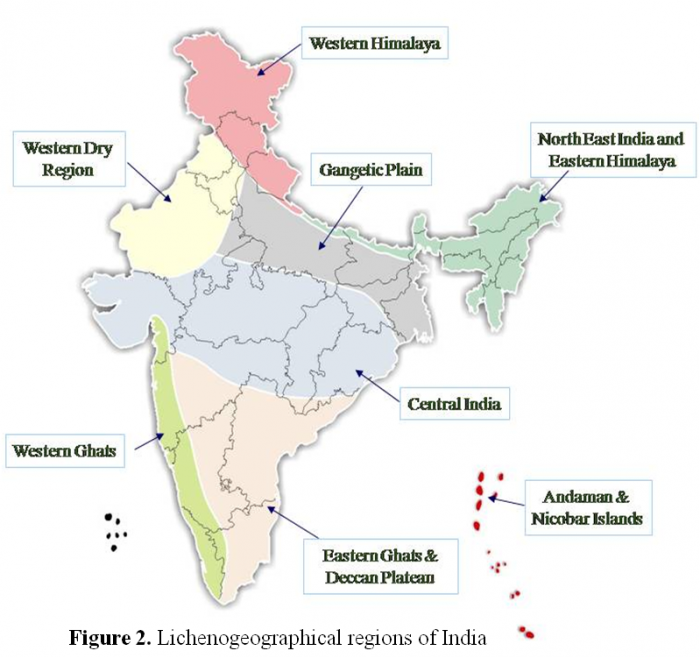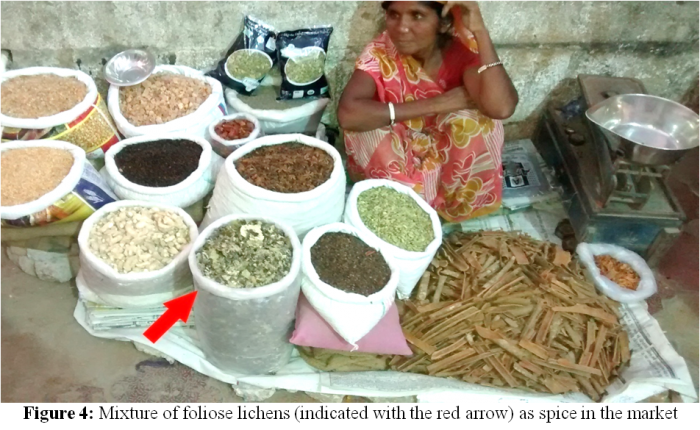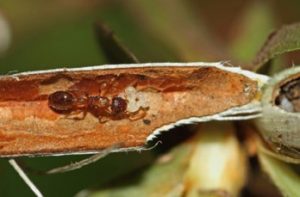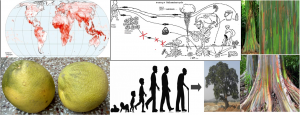Not many people are aware of lichens though they must’ve seen them growing as differently shaped and colored patches covering the tree barks or buildings around them. Often they also mix up lichens with mosses which is far from the truth because mosses are primitive non-vascular plants having plant-like structures and chloroplasts throughout their bodies. Lichens, on the other hand, do not have any plant like structures and exhibit different colors such as green, grey, red, yellow, etc., in their thallus, unlike the mosses which are mostly green colored fluffy patches. The lichens are unique organisms owing to the intricate symbiotic relationship they portray wherein both its heterotrophic (fungus) and autotrophic (green algae/cyanobacteria) partners together form a single plant thallus. The mycobiont part of lichen provides the shelter, aids in the assimilation of moisture, micro and macronutrients for the photosynthetic partner to grow and in turn receives the carbohydrates for their metabolic activity. Lichens are usually slow-growing, long-lived and stress tolerant organisms chiefly grouped into three morphological groups – crustose (crust-like), foliose (leaf-like) and fruticose (beard-like) forms. Based on the substratum where lichens grow, they can be classified as corticolous (growing on the tree trunks and bark), saxicolous (growing on the rocks and boulders), terricolous (growing on soil), foliicolous (growing on evergreen leaves) and muscicolous (growing on moss) (Figure1). The symbiotic relationship coupled with the ability to quickly absorb and retain water from different sources enable lichens to grow and live successfully in all types of environments including the polar regions and the deserts (Bhat et al., 2011).
as green, grey, red, yellow, etc., in their thallus, unlike the mosses which are mostly green colored fluffy patches. The lichens are unique organisms owing to the intricate symbiotic relationship they portray wherein both its heterotrophic (fungus) and autotrophic (green algae/cyanobacteria) partners together form a single plant thallus. The mycobiont part of lichen provides the shelter, aids in the assimilation of moisture, micro and macronutrients for the photosynthetic partner to grow and in turn receives the carbohydrates for their metabolic activity. Lichens are usually slow-growing, long-lived and stress tolerant organisms chiefly grouped into three morphological groups – crustose (crust-like), foliose (leaf-like) and fruticose (beard-like) forms. Based on the substratum where lichens grow, they can be classified as corticolous (growing on the tree trunks and bark), saxicolous (growing on the rocks and boulders), terricolous (growing on soil), foliicolous (growing on evergreen leaves) and muscicolous (growing on moss) (Figure1). The symbiotic relationship coupled with the ability to quickly absorb and retain water from different sources enable lichens to grow and live successfully in all types of environments including the polar regions and the deserts (Bhat et al., 2011).
With more than 19,300 species of lichens existing worldwide, they are known to dominate approximately 8% of the Earth’s land surface (Lucking et al., 2016; Nash, 2008). India, being a biodiversity rich country, is also home to more than 2700 lichen species, of which about 20% are endemic to Indian boundaries and this number keeps updating with newer explorations and discoveries (Sinha et al., 2018).  Based on the available information, the country is broadly divided into eight different lichenogeographical regions –Western Himalaya, Eastern Himalaya, Western Ghats, Eastern Ghats & Deccan Plateau, Andaman & Nicobar Islands, Central India, Gangetic Plain and Western Dry Region (Figure 2). Among these, the Eastern Himalaya and the Western Ghats harbor maximum diversity of lichens with over 1100 species each. However, the Western Ghats harbors maximum number endemic taxa (266 taxa) in comparison to Eastern Himalayan region (187 taxa) (Nayaka & Asthana, 2014).
Based on the available information, the country is broadly divided into eight different lichenogeographical regions –Western Himalaya, Eastern Himalaya, Western Ghats, Eastern Ghats & Deccan Plateau, Andaman & Nicobar Islands, Central India, Gangetic Plain and Western Dry Region (Figure 2). Among these, the Eastern Himalaya and the Western Ghats harbor maximum diversity of lichens with over 1100 species each. However, the Western Ghats harbors maximum number endemic taxa (266 taxa) in comparison to Eastern Himalayan region (187 taxa) (Nayaka & Asthana, 2014).
Besides being an integral and important part of biodiversity, the lichens are highly valued as ecological indicators for a variety of environmental parameters like air quality and climate change. The lichen growth and diversity is mainly influenced by the air quality, microclimatic parameters, forest management systems, tree species composition, and their bark characteristics as well as the anthropogenic factors. Hence, the lichen diversity in natural habitats has often been used as a general indicator of forest health and ecological functions (Will-Wolf et al., 2002) as the lichens are key primary producers in an ecosystem and linked to its food webs as well as the nutrient cycling. For example, a high growth of parmeliod lichens (members of lichen family Parmeliaceae) indicates drier climate and open forests as these lichens are photophilic (preferring high light intensity) in nature.  On the other hand, the luxuriance of lichens belonging to Graphidaceae, Porinaceae, and Pertusariaceae indicate a more humid environment and forests with dense canopy having low light penetration (Phatak et al., 2004; Plata et al., 2008).
On the other hand, the luxuriance of lichens belonging to Graphidaceae, Porinaceae, and Pertusariaceae indicate a more humid environment and forests with dense canopy having low light penetration (Phatak et al., 2004; Plata et al., 2008).
Lichens are also known to accumulate metals and other pollutants like nitrogen and sulfur compounds from the atmosphere as dry or wet deposition. This accumulation occurs by particulate trapping, active uptake of anions and passive absorption of cations (Nieober et al., 1978). The amount of macronutrients such as nitrogen, sulfur, potassium, magnesium, and calcium in the lichen thallus changes seasonally whereas the trace elements such as cadmium, zinc, etc. are accumulated slowly in the thallus owing to their less mobility as compared with former. Due to these properties, the elemental compositions of lichen thallus has been useful in many studies for mapping the pollution depositions or for characterizing pollution gradients in the atmosphere. Even though the elemental compositions do not directly provide information on the total deposition at a particular site, they do serve as a useful tool for informing relative patterns of deposition.
In India, the accumulation of metal (Al, Cd, Cu, Cr, Fe, Pb, Ni, Zn) pollutants in lichen thallus by passive as well as active principals is well documented from different cities of the state of Uttar Pradesh (Faizabad, Lucknow, Kanpur and Raebareli district), Madhya Pradesh (Dhar, Katni and Rewa district), West Bengal (Hooghly and Nadia district), Maharashtra (Pune and Satara district) and Uttarakhand (Dehradun and Pauri district) (Shukla & Upreti, 2007).  Among the various lichens in India, Pyxine cocoes (Figure 3) which is a foliose lichen commonly growing on the mango trees has been found to be an excellent organism for determining the pollutants emitted from the coal-based thermal power plant. Similarly, another tropical lichen species Phaeophyscia hispidula belonging to the same lichen family as that of Pyxine bears a thick tuft of hairlike rhizines which act as a metal reservoir and exhibit higher accumulation of most of the metals (Upreti et al., 2015). This excellent accumulation potential of lichens coupled with their sensitivity to acidic gases and presence of distinct morphological and/or physiological symptoms makes them successful bioindicators of air pollution.
Among the various lichens in India, Pyxine cocoes (Figure 3) which is a foliose lichen commonly growing on the mango trees has been found to be an excellent organism for determining the pollutants emitted from the coal-based thermal power plant. Similarly, another tropical lichen species Phaeophyscia hispidula belonging to the same lichen family as that of Pyxine bears a thick tuft of hairlike rhizines which act as a metal reservoir and exhibit higher accumulation of most of the metals (Upreti et al., 2015). This excellent accumulation potential of lichens coupled with their sensitivity to acidic gases and presence of distinct morphological and/or physiological symptoms makes them successful bioindicators of air pollution.
The lichens have also been a part of household items in India since ancient times with their major collections from the Western Ghats and the hilly regions in the Himalayas. Mostly the parmeliod lichens such as Parmotrema, Everniastrum, Bulbothrix, and Hypotrachyna are used by the indigenous communities mainly as spices and condiments (Figure 4) as well as for preparation of perfumes and dyes. Many commercially packed ‘Garam masala’ or ‘Sambhar masala’ also contain lichen powder or whole plants as major ingredients.
The medicinal properties of lichens have also been recognized around the world including India. The reported biological activities including antimicrobial, anti-inflammatory, analgesic, antipyretic, anti-proliferative and cytotoxic effects are suggested to be due to the presence of a diverse array of chemical compounds which even raise interest of the pharmaceutical industries (Boustie & Grube, 2005). In traditional medicine system of Ayurveda, the vernacular name of lichens ‘Chharila’ is widely used in the treatment of headache, skin diseases, urinary trouble, boils, vomiting, diarrhoea, dysentery, heart trouble, cough, fever, leprosy and as a blood purifier (Nayaka et al., 2010). Chandra & Singh (1971) provided a detailed description of crude drug ‘Chharila’ sold in Indian markets which comprises three species of Parmelia lichen. Besides this, the lichens have been extensively studied for the unique secondary metabolites and so far about 1500 are identified (Huneck & Yoshimura, 1996).
Apart from their usefulness to the humans, lichens play a crucial role in supporting varied ecological functions related to the wildlife. They serve as food resources, shelters as well as nesting materials for different animals such as deer, elk, mountain goats, antelopes, squirrels, mice, bats, etc. Species such as Ramalina fraxinea is eaten by squirrels while various species of Cladonia are eaten as key winter foods by the reindeers. Besides, there are some species of grasshoppers, butterflies, moths, spiders, snails, and slugs which camouflage themselves as lichens. For example, the insect – lichen Katydid camouflages itself so intricately that even its dark solid body is etched with lines that look like the lichen, creating the illusion that this is nothing more than a strange tuft of tangled lichen branches.
Despite there being so many uses and applications of lichens, they still remain a mystery to the common people. We see them growing as colored patches on tree trunks, rocks, monuments and many places around us but we choose to ignore these dynamic elements of nature. However, a significant increase in the lichen studies especially in the last couple of years points out to a renewed interest among the researchers which has helped enhance the knowledge of diversity and use values of lichens.
References:
1) Bhat SP, Dudani SN, Subash Chandran MD & Ramachandra TV (2011) Sahyadri Shilapushpa – Lichens: General Characteristics. Sahyadri E-News Issue – 34, Centre for Ecological Sciences, Indian Institute of Science, Bangalore.
2) Boustie J & Grube M (2005) Lichens – a promising source of bioactive secondary metabolites. Plant Genetic Resources 3, 273–287.
3) Chandra S & Singh A (1971) A lichen crude drug (Chharila) from India. Journal of Research in Indian Medicine 6(4), 209–215.
4) Huneck S & Yoshimura Y (1996) Identification of lichen substances. Springer, Berlin, Heidelberg, New York. Nash TH (2008) Lichen Biology. Cambridge University Press, Cambridge.
5) Nayaka S & Asthana S (2014) Diversity and distribution of lichens in India vis a vis its lichenogeographic regions. In: Marimuthu T, Ponmurugan P, Subramanian M, Mathivanan N, Anita S (Eds) Biodiversity Conservation – Status, Future and Way Forward. Chennai, India: National Academy of Biological Science, pp. 79–96.
6) Nayaka S, Upreti DK & Khare R (2010) Medicinal lichens of India. In: P.C. Trivedi (Ed.) Drugs from Plants. Avishkar Publishers, Distributors, Jaipur, India.
7) Nieboer EA, Richardson DHS & Tomassini FD (1978) Mineral uptake and release by lichens: an overview. The Bryologist 81(2), 226–246.
8) Phatak S, Nayaka S, Upreti DK, Singh SM & Samuel C (2004) Preliminary observation of lichen flora of Cotigao Wildlife Sanctuary, Goa, India. Phytotaxonomy 4, 104–106.
9) Plata RS, Lucking R & Lumbsch HT (2008) When family matters: an analysis of Thelotremataceae (Lichenized Ascomycota: Ostropales) as bioindicators of ecological community in tropical forests. Biodiversity Conservation 17, 1319–1351.
10) Shukla V & Upreti DK (2007) Heavy metal accumulation in Phaeophyscia hispidula en route to Badrinath, Uttaranchal, India. Environmental Monitoring and Assessment 131: 365–369.
11) Sinha GP, Nayaka S & Joseph S (2018) Additions to the checklist of Indian lichens after 2010. Cryptogam Biodiversity and Assessment 197–206.
12) Upreti DK, Bajpai R & Nayaka S (2015) Lichenology: Current Research in India. In: Bahadur B, Rajam MV, Sahijram L & Krishnamurthy KV (Eds.) Plant Biology and Biotechnology Vol. I: Plant Diversity, Organization, Function and Improvement. Springer India.
13) Will-Wolf S, Scheidegger C, McCune B (2002) Methods for monitoring biodiversity and ecosystem function. Monitoring scenarios, sampling strategies and data quality. In: Nimis PL, Scheidegger C, Wolseley P (Eds) Monitoring with lichens: monitoring lichens. Kluwer, Dordrecht.
About Author :




